Story at a glance:
- Spectorgroup’s 838 Broadway rehab offers insights on how to reduce material use while respecting the authenticity of historic buildings.
- Authenticity was key to the interior redesign, with inspiration drawn from the building’s original facade.
- Focusing on the structural features, like high ceilings, brick walls, and large windows reduced materials used for design.
There’s a common adage in the architecture and design community—the most sustainable building is the one that is already built. It’s reflective of the fact that, when you factor in the emissions from the material extraction, transportation, and manufacturing processes, rehabbing an existing building is still generally greener than building high-performance new construction.
It’s a mantra that Sara Agrest, design director and senior associate at Spectorgroup, brought to her work leading interior design and branding on the historic preservation and renovation of 838 Broadway in New York City. “This is why we did this project,” she says. “New York City has incredible buildings that need to be maintained and celebrated. Our design and construction community has an obligation to preserve these buildings; they’re intrinsic to the fabric of the city.”
In the historic Union Square neighborhood, 838 Broadway was originally built in 1876 and served a wide variety of uses over its 150-year lifespan, including housing New York University administrative offices for the past 50 years or so.
The rehab project brought the building into the modern era, transforming the lobby and three floors of offices into contemporary, amenity-rich workspaces that pay homage to the rich architectural history of the building and neighborhood.
Agrest recently sat down with gb&d to discuss her work on 838 Broadway, the importance of historical preservation, and how updated building codes drive sustainability.
What was the mission for 838 Broadway?
- Designed by Stephen Decatur Hatch in 1876, what is now 838 Broadway was built on the site of President Theodore Roosevelt’s great-great uncle James T. Roosevelt’s home. Photo by Connie Zhou, courtesy of Spectorgroup
- Spectorgroup’s transformation of 838 Broadway demonstrates the sustainability of historic preservation. Photo by Connie Zhou, courtesy of Spectorgroup
Overall the client’s goals were always office space, but they knew they wanted something really special. They realized that in order to achieve the vision they wanted, they would need to find high-end firms that would appreciate both the location—which is phenomenal—the building, and then just the general detail we were going to put into the project.
In terms of sustainability the goal was to increase efficiency by replacing all of the existing building systems, which would enable them to provide Class A office space for future tenants. Many of the building system upgrades were mandated by New York City building codes, which shows that city codes really do make a difference in the built environment.
By completely replacing all existing building systems, we were in 100% compliance with all of the latest codes, which are exponentially more efficient than those put into place in the 1970s [the last time the building was renovated].
How did the design motif inspire your work?

Authenticity was key to the interior redesign, with inspiration drawn from the building’s original facade. Photo by Connie Zhou, courtesy of Spectorgroup
As a New Yorker I was over the moon; it was this gift to me to work on this project. There was no way we’d do an imitation of the original architecture, so it had to be an interpretation and making it into this modern but edgy juxtaposition in some ways.
In our research we discovered that a lot of the competition in terms of Union Square office space in similar buildings of that era, there wasn’t a lot of consideration of incorporating the original architecture. Everything seems like it was applied to the inside; it was like you could be anywhere. You had no idea you were in this historic building. It was just your typical office space.
I realized there’s a really interesting window shape; it’s not just a simple curve, it’s an inverted curve in the corners and then arches, and that was something that seemed unique to this building. The windows became part of the inspiration for the lobby—that sort of trellis you walk through is a repeated three-dimensional image of that motif. It was very much inspired by that turn-of-the-century building with a vaulted ceiling. We’re sort of flipping that, and it’s made up of the metal pieces tracing the geometry of the windows.
That became the logo for the building, and I think that was a perfect example of creating something that was super authentic to the brand and the building that wasn’t something that was overlaid. It came out naturally.
What were the biggest challenges?

Focusing on the structural features, like high ceilings, brick walls, and large windows, reduced materials used for design. Photo by Connie Zhou, courtesy of Spectorgroup
This is a small building, which meant we didn’t have unlimited space. In that way it was like a jigsaw puzzle figuring out how to orient the stairs and elevators while ensuring everything was code compliant. At the same time, because it was a gut renovation, we had more freedom to arrange the pieces of the puzzle.
The process of installing all-new building systems required us to be creative in figuring out where the ductwork and pipework would fit in the space. We had to ensure everything was arranged perfectly in these very tight floor plans to maximize efficiency.
Many of our reconfigurations were geared toward enhancing the building experience. The original entrance layout was inconvenient for visitors who had to schlep all the way to the back for the elevators. We replaced the 50-year-old elevators and rearranged the layout to bring them further toward the front. We wanted to do everything we could to make the space feel better. The domino effect of our choices in the lobby made all of the upper floors more efficient as well.
What are the current trends in preservation and renovation?
I was thinking so much about the fact that there was this big break during Covid. In my experience we stopped focusing on trends because we weren’t around each other as much to keep those trends alive, and people went back to authenticity and a blank slate, and this was something that was really important to me. I would say that is the current trend, but it’s also a non-trend.
For a while people were slapping Instagrammable moments onto everything … now we’re getting away from that.
For a while people were just slapping “Instagrammable” moments onto everything, and that’s what you had in a lot of office spaces—kitschy, corny things that were superficial, and now we’re getting away from that. I am extremely modern in my design thinking, but that’s what I love about historic rehab; you don’t have to keep everything, but it’s incredible how the things you can keep transform the space by incorporating these different elements, and it does make it more authentic.
Why is historic preservation and retrofitting so important to sustainability?

Spectorgroup transformed 838 Broadway in New York City. Photo by Connie Zhou, courtesy of Spectorgroup
Here at Spectorgroup we do subscribe to the notion that the greenest building is a building that already exists. This building is such a gem; there was no need to cover everything up with extra materiality. Instead we let the architecture do the heavy lifting. The high ceilings, brick walls, and large windows were all natural elements that were already there.
In general using fewer materials is inherently more sustainable. Using less saves energy required for transporting materials and also reduces the amount that will end up in a landfill 20 years from now. A minimal approach helps to ensure the space will be in use for longer, without requiring additional renovations every few years.
We also saw the space as a kind of art gallery. The space will house people doing their daily work, and the architecture is intended to be a complementary surrounding rather than making its own statement. This enables the space to be more flexible for future tenants who will come in and want to make the space their own. This is the magic of a pre-built office space—it’s a blank slate with infinite possibilities.







